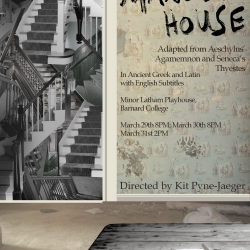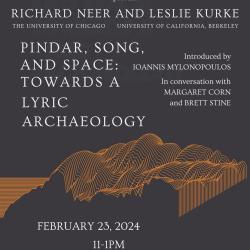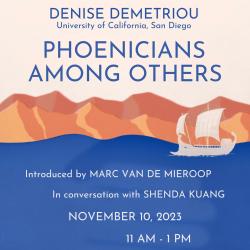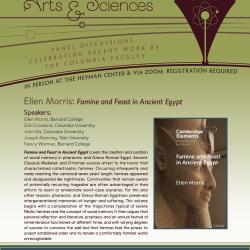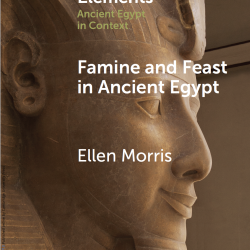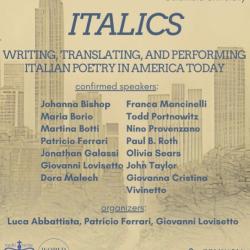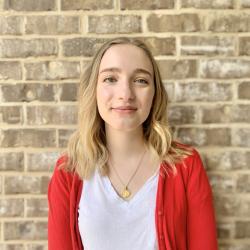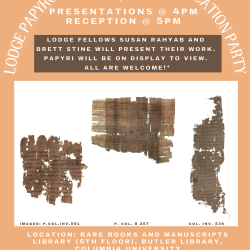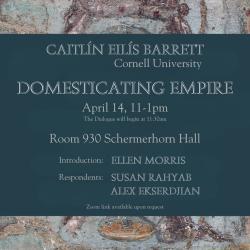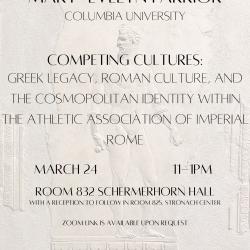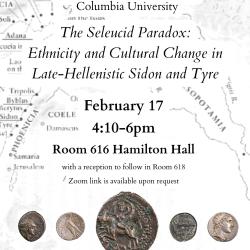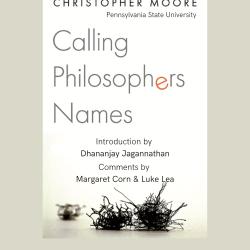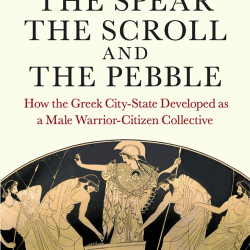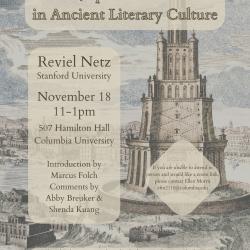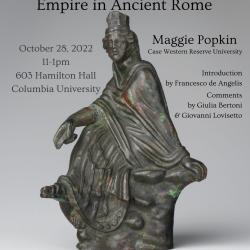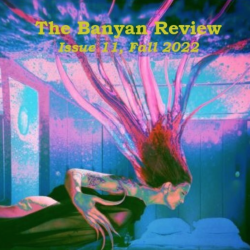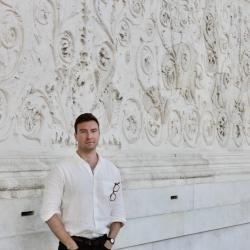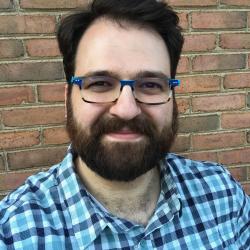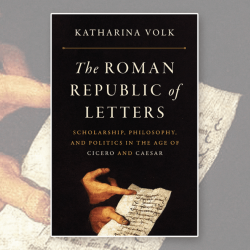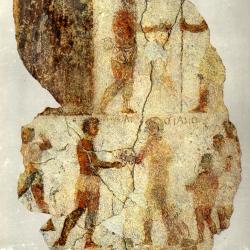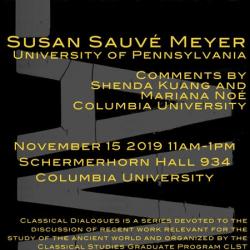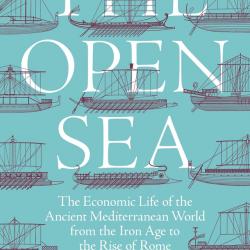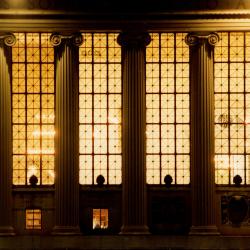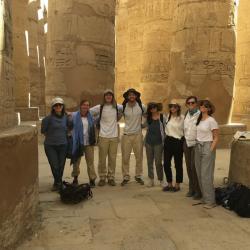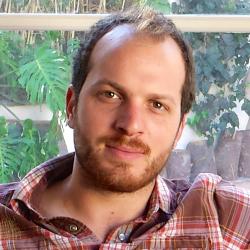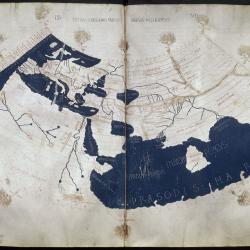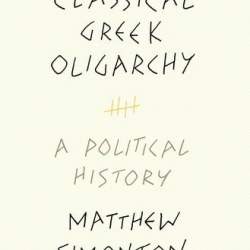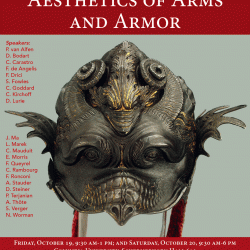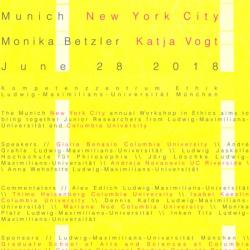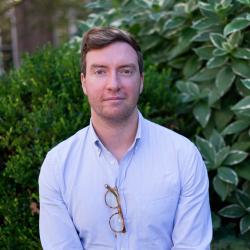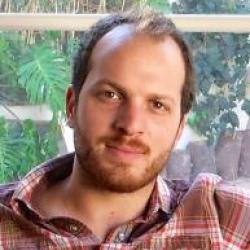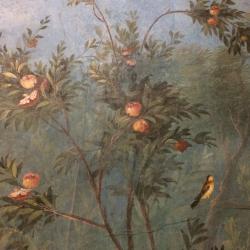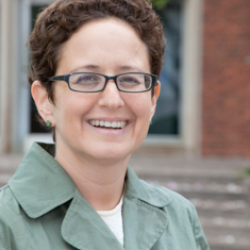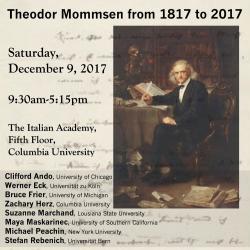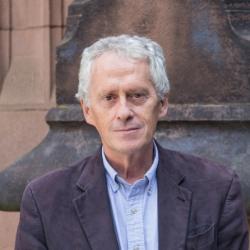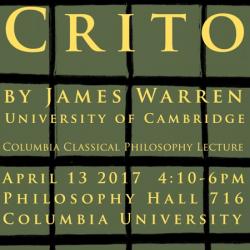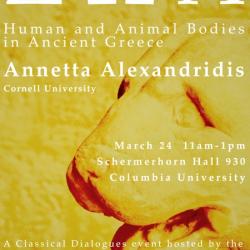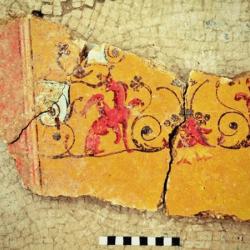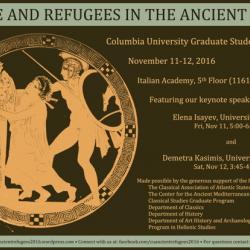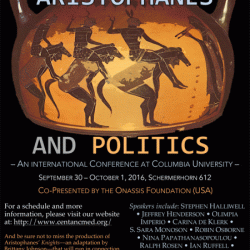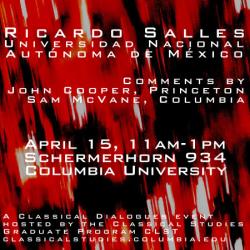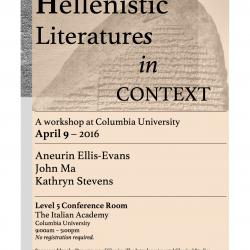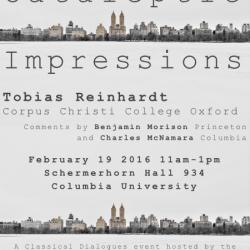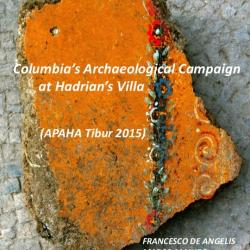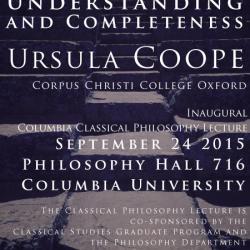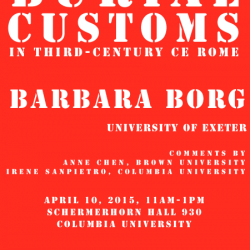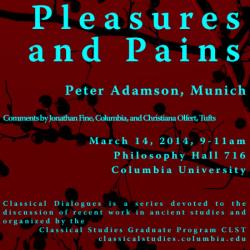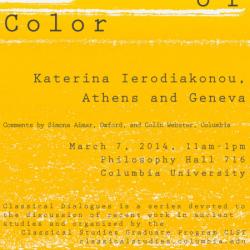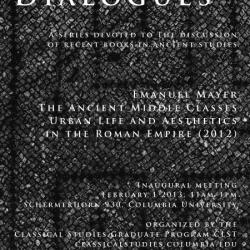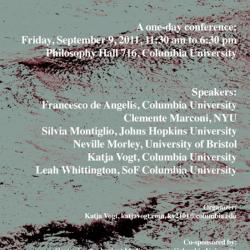Throughout the summer, we are posting photos from places where the CLST students travel, do research, excavate, and teach.
This week’s winner is Kathryn Minogue-Nachison. After a research trip early in the summer (photos below), Kathryn joined the team of Professor Ioannis Mylonopoulos, who directs a new excavation project at the sanctuary of Poseidon at Onchestos. Photos and descriptions Kathryn Minogue-Nachison.

Members of the Onchestos excavation team, by Kathryn Minogue-Nachison. Cheers! After a long week, the team takes a few moments to participate in the modern rituals associated with Dionysus.
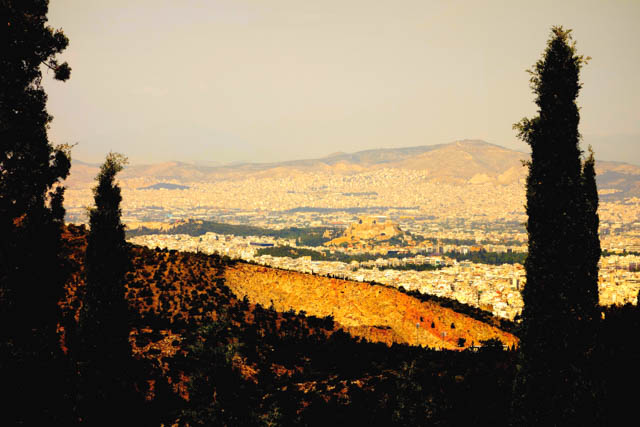
View of Athens from Mount Hymettos, by Kathryn Minogue-Nachison. Near the beautiful Kaisariani Monastery on Mount Hymettos we caught a glimpse of the city below. Even in the midst of the modern urban sprawl the Athenian Acropolis maintains its visual prominence.
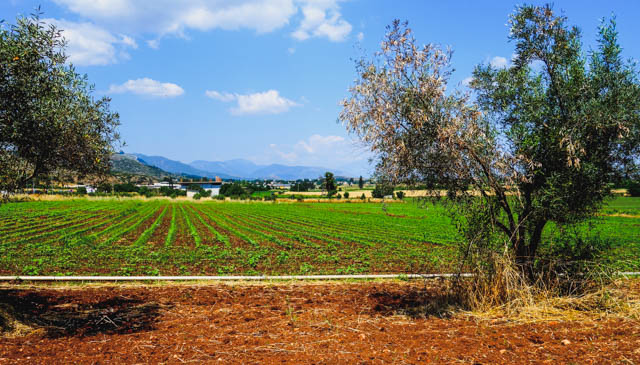
Old Kopais, by Kathryn Minogue-Nachison. Onchestos is located at the edge of what was Lake Kopais. In Mycenaean times a complex water management system was used to drain the lake and redirect incoming water. This system created a great expanse of rich and fertile land (seen here) that continues to be a critical resource for the agricultural economy of Boiotia.
This week’s winner is Joe Sheppard whose photos from the Global Class at Villa Adriana are posted below. After his research and work as trench supervisor at Tivoli, Joe went to Villa San Marco at Stabiae, APAHA’s first excavation site. Work at Stabiae began in 2011/12 and is by now far advanced. The project is directed by Professor Francesco de Angelis and Professor Marco Maiuro, and Joe has been part of it right from the start. Photos and descriptions by Joe Sheppard.
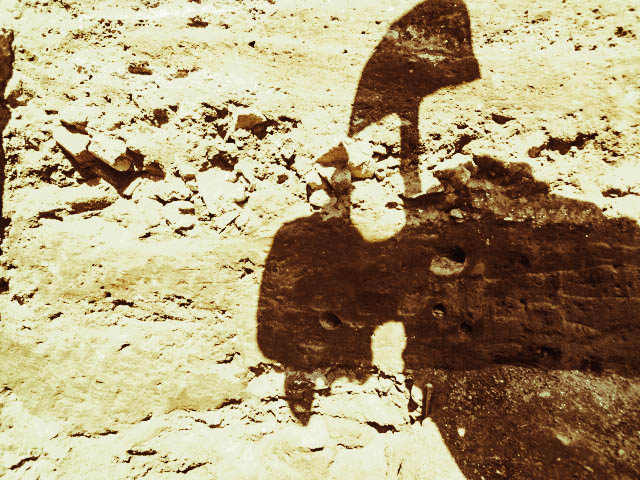
Shadow cast across section, Villa San Marco, by Joe Sheppard. By keeping the baulks of the trench vertical and clean, the complex stratigraphic sequence of floor surfaces, fill deposits, and cuts always remained accessible and legible for the excavators working in the courtyard.

Work in a garden at Villa San Marco in Castellammare di Stabia, Italy, by Joe Sheppard. This year new evidence was found for a garden at Villa San Marco. Here Columbia College student Andrew Bair carefully removes the last soil from around a root cavity he has cast in plaster of paris, with two more casts pedastalled in section behind him.
This week’s winner is Evan Jewell, who studied in Italy this summer, first participating in APAHA’s Villa Adriana project, then in a workshop on Latin Epigraphy. Evan sent us photos of sites in and near Rome—some famous, others less visited by tourists and scholars. By the end of the summer, Evan’s captions for his photos displayed a nice change: he was no longer sending images from Rome, but from Roma. Photos and descriptions by Evan Jewell.
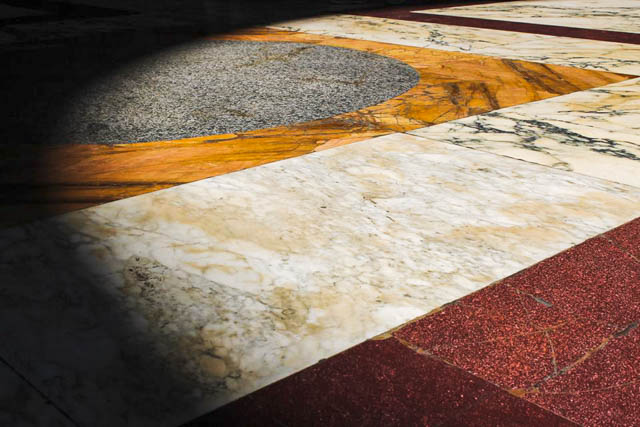
The Pantheon, Rome, by Evan Jewell. The play of light from the Pantheon’s oculus upon its rich, marble floor (opus sectile) has probably caught the attention of visitors throughout its history. Although I had visited it a few times previously, this time the Pantheon’s play of light and darkness took on a new significance for me as focalising device: the moving circle of light highlights and circumscribes the luxurious and costly floor as a showpiece in itself in different places throughout the day–offering a new view at different moments–and this may have drawn the viewer’s attention before, rather than after the decoration of the walls and the many statues in niches. It goes to show how we can re-discover a well-worn monument for ourselves with each re-visit.
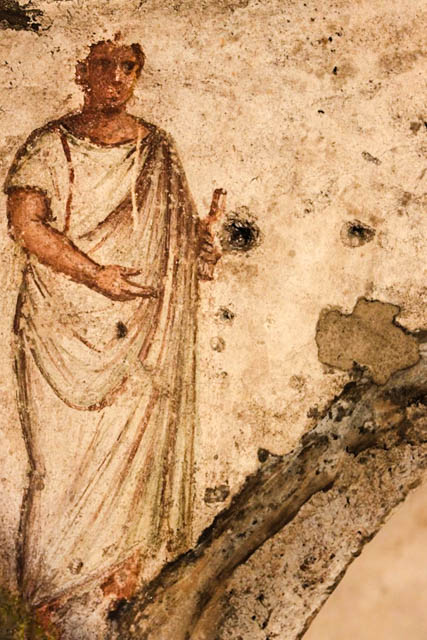
Aqueduct Park, part of the Parco Regionale dell’Appia antica, by Evan Jewell. The stunning aqua Claudia, with Anio Novus atop it, still stands in all of its engineering splendor.
This week’s winner is Nicholas Lamb, who spent much of the summer traveling in Greece visiting sites, museums, and theatre performances. Below are two images that Nicholas describes as particularly meaningful to him. Photos and descriptions by Nicholas Lamb.
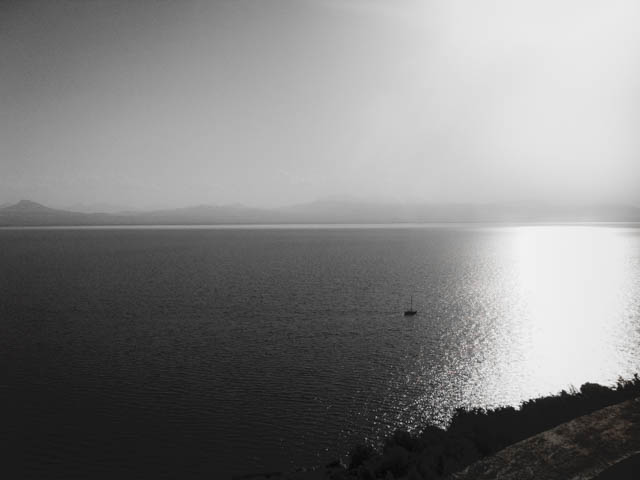
View across the Gulf of Corinth looking towards ancient Corinth, Greece, by Nicholas Lamb. As George Seferis wrote, “Wherever I travel Greece wounds me.” This photo, for me at least, captures something of that which Seferis was speaking about.

Sixth century B.C. tablet, by Nicholas Lamb. One of my favorite objects in the National Museum of Athens was found near ancient Corinth. This painted tablet is made of wood and it is truly amazing that it has survived! It depicts a scene of sacrifice and was found in a cave near the village of Pitsa. Some date it to the second half of the sixth century B.C.
This week’s winner is Nora Donoghue. Nora spent June at the APAHA project at Villa Adriana, July excavating at Poggio Civitate in Tuscany, and quite a few weekends in between traveling and exploring further sites in Italy. She sent us photos from Boscoreale, which is just north of Pompeii in Campania, and from Poggio Civitate in Tuscany. Photos and descriptions by Nora Donoghue below.

Boscoreale, Campania, Italy, by Nora Donoghue. The rustic villa at Boscoreale was destroyed in the eruption of Vesuvius in 79. It is well known for the farming implements found there, as well as casts of trees which still stand in the garden.
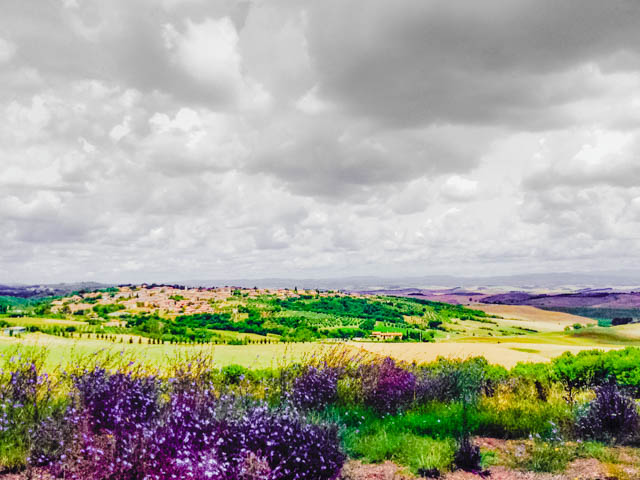
Valley of the Arbia River surrounding Piano del Tesoro, Tuscany, by Nora Donogue. This and the photos below are from Poggio Civitate, an Etruscan site about 20 km south of Siena. The photo shows the hill we work on, where Poggio Civitate is situated. Unfortunately all of the structures are back filled because the land is owned privately. Famous in modern times for the Chianti grapes grown in the area, in ancient times the valley of the Arbia River was probably home to small Etruscan settlements but has never been excavated. The Arbia River allowed the Etruscans transportation to other important sites as the river connects to the large and more influential Ombrone River.

View of Murlo in Tuscany, by Nora Donoghue. From Poggio Civitate, one can see the Medieval town in Murlo, Tuscany. Built as a living complex for a bishop, the connected buildings are now divided and home to 30 people. The town is also home to the excavation’s conservation lab, storage, as well as the site museum which is the tallest building visible in the town.

Ivo Rubegni at Poggio Civitate, by Nora Donoghue. Ivo Rubegni, a local farmer and friend of the excavation, helps fix the bottom portion of the path used to hike to site after a sudden hail and thunderstorm.

Sunset over the hills of Poggio Civitate, Tuscany, by Nora Donoghue.
This week’s winner is Moshiko Hamo. Moshiko sent us photos from his hometown Denver, where he is currently completing his M.A. thesis on Aristotle’s Nicomachean Ethics. Moshiko is writing about Aristotle’s claim that the life of contemplation is the best life, and about the question of whether that kind of life is even possible for mere mortals. He is interested in Aristotle’s views on humans and gods: why, according to Aristotle, we should not accept the advice “humans you are, think human thoughts,” and what it means to assimilate, as far as possible, to the immortals. Photos and descriptions by Moshiko Hamo.
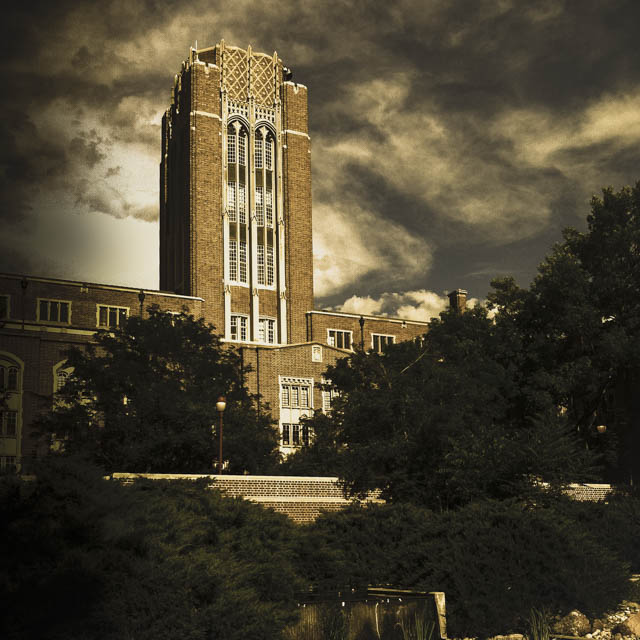
University of Denver, by Moshiko Hamo. This summer I’ve been writing my MA thesis in my hometown at the University of Denver. With its open spaces and some of the most beautiful architecture in Colorado, the campus has been excellent for clearing my mind and contemplating Aristotle’s Nicomachean Ethics.
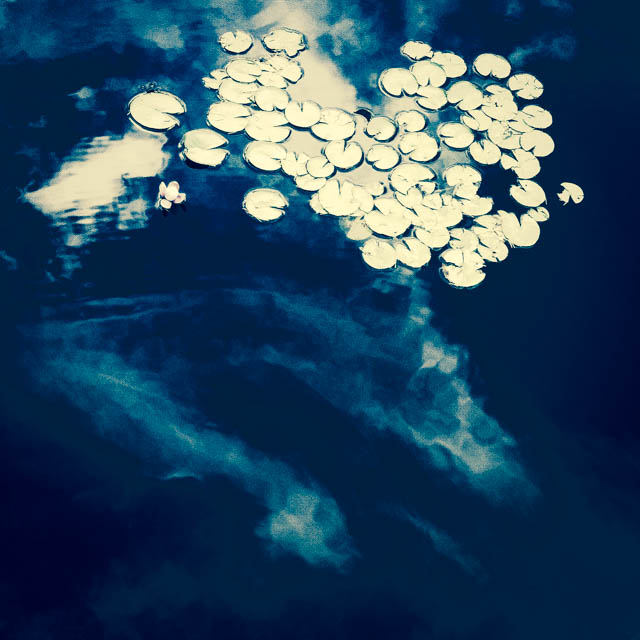
Lily ponds, by Moshiko Hamo. Scattered about the campus are lily ponds. One can see the wide western sky reflected in them.

Campus University of Denver, by Moshiko Hamo. Aristotelians believe that leisure is a precondition for reflective activity, theoria. Accordingly, these tranquil landscapes have been conducive to reflections about happiness and the divine.
This week’s winner is Joe Sheppard. Joe sent us images from the Villa Adriana excavation, co-directed by Francesco de Angelis and Marco Maiuro. Joe served as trench supervisor on site, and as teaching assistant for the 4000-level CLST course that took place for the first time this June. Below we already posted Evan’s photos from Villa Adriana in the rain, and here are more impressions from the students’ work.
Joe entitled his photos “Natural Capital.” In his words, “[t]oday the Villa Adriana in Tivoli is a verdant archaeological park for visitors to enjoy, with endless olive groves and cool paths shaded by poplar trees. The original villa also harnessed the landscape of the Tiburtine hills to create a grand yet secluded summer residence for the emperor and his court, but it is easy to forget about nature as we experience the site as a staggeringly costly and innovative construction project. I wanted to capture this tension between nature and human intervention by juxtaposing the two.”
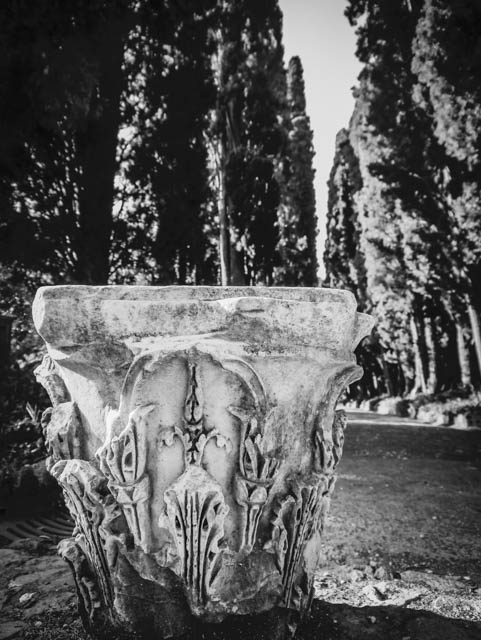
Villa Adriana, Tivoli, fragment of a Corinthian capital, near the so-called Poikile, by Joe Sheppard. Here as in the images below, I focussed on the ubiquitous acanthus as a motif — both the juicy stalks rising in bloom at the time, and crisp leaves unravelling in marble atop richly decorated Corinthian capitals.
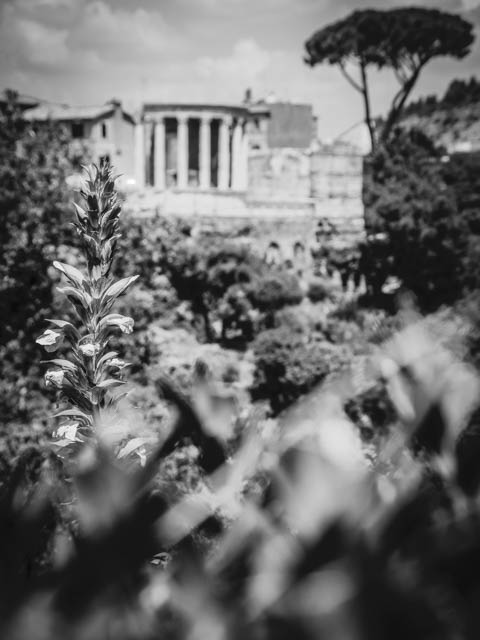
Villa Adriana, Tivoli, so-called Temple of the Sibyl, surrounded by the Villa Gregoriana and the town of Tivoli, by Joe Sheppard. When we climbed the hill to visit the so-called Temple of the Sibyl, it was clear that the earlier architects there had also designed the late-Republican structure with the natural surroundings in mind — in this case the river roaring down the precipitous chasm beneath.
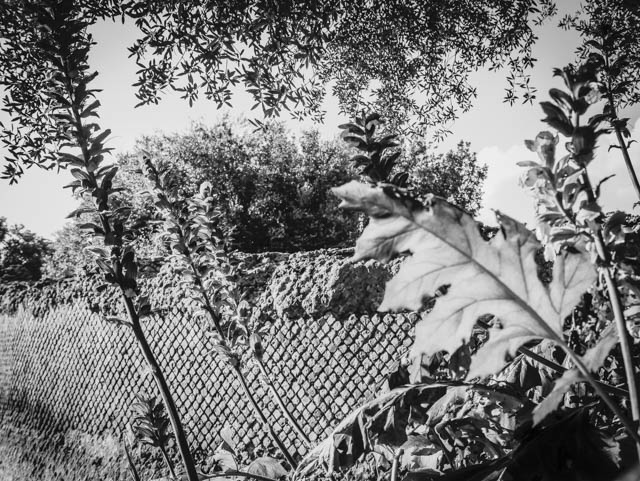
Villa Adriana, Tivoli, Reticulate wall behind screen of acanthus and olive, by Joe Sheppard.
This week’s winner is Molly Allen. Molly sent us pictures from Greece, where she is participates in a new excavation project by Professor Ioannis Mylonopoulos. During the weekend, she took a trip, together with some Columbia art history students, to Orchomenos, Ptoos and Gla. Photos and descriptions by Molly Allen.
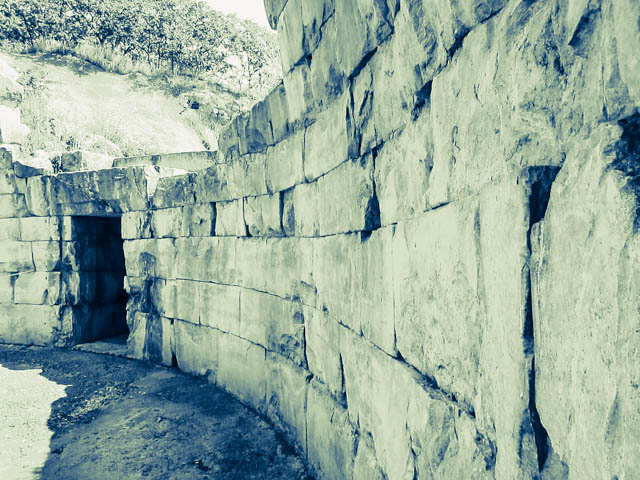
Orchomenos, Greece, by Molly Allen. The picture is taken from the entrance of the tholos tomb at Orchomenos, emphasizing the curve of the beehive-shaped structure. It was Schliemann who first excavated at the site and exposed the tomb which he dubbed the “Tomb of Minyas” after the legendary founder of Orchomenos. The tholos was used in post-Mycenaean times as a sacred space. A marble platform, probably dating to the Hellenistic period, still remains within the tholos and likely displayed divinities in the Hellenistic period and emperors during the Roman period.

Orchomenos, Greece, by Molly Allen. The image shows Matt Peebles (PhD Columbia, art history) taking a picture of the ornately decorated ceiling of the chamber tomb which juts out from the northeast side of the “Tomb of Minyas.” The ceiling contains relief decoration with spirals, rosettes and papyrus flowers, etched into enormous limestone blocks. The tomb was plundered in antiquity but the tholos structure was intact at least until the 2nd century AD, when Pausanias wrote about its impressive structure (9.38.2-3).
This week’s winner is Evan Jewell. Evan sent us photos from Villa Adriana, where several CLST students participated in a new initiative by Francesco de Angelis and Marco Maiuro: a 4000-level CLST course entitled Hadrian’s Villa: The Archaeology of an Imperial Court. The first two images show the UNESCO World Heritage site after torrents of rain. Luckily, work could proceed as planned, and we’ll soon post some of the findings. Photos and descriptions by Evan Jewell. Below is also a “postcard” that memorizes a visit at nearby Villa d’Este.
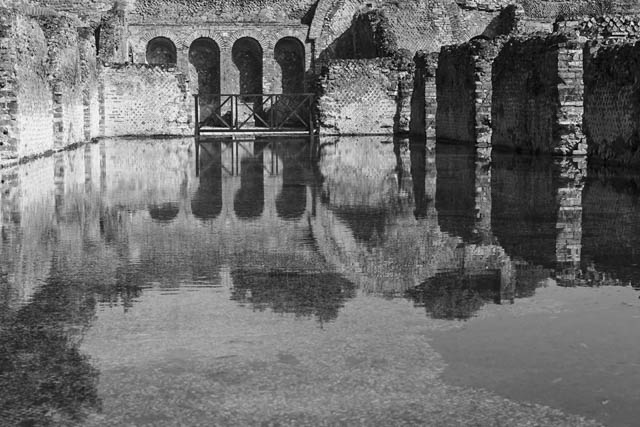
The Hospitalia, Villa Adriana, Tivoli, by Evan Jewell. This past week has seen some terrible tempests reek havoc in parts of the villa and disrupt our digging. Nevertheless, the weather has highlighted a part of ancient villa life that is all too often forgotten or ignored, particularly in the clear light of a sunny summer’s day: how did the villa brave the force of the elements? Did the villa face the threat of flash-flooding? What was the architecture of an effective drainage system? These questions and more began brewing with the storms and they are probably worth exploring more, especially if we recall that the villa was designed in such a way to harness its surrounding environment for the purposes of otium, aesthetics, and good health.

The Pecile, Villa Adriana, Tivoli, by Evan Jewell. Rain in early June, which was the second week of the excavation project.

From left to right: Nora Donoghue, Jeremy Simmons, Joe Sheppard, and Evan Jewell at Villa d’Este in Tivoli.
This week’s winner is Sam McVane, jointly with Ursula Poole. Sam teaches an Intensive Latin class in Columbia University’s summer session. He’ll teach Greek in the Fall semester, and a new course on Stoic philosophy in the Spring of 2015. Ursula Poole, Ph.D. student in Columbia’s Classics Department, kindly visited Sam’s summer class to take photos. Descriptions by Sam McVane.

Sam’s Latin class, by Ursula Poole. For the dedicated few, Columbia offers 6-week intensive ancient language courses during the two summer sessions. My Elementary Intensive Latin class, pictured here, covers the equivalent of a full year’s worth of introductory Latin, basically all of Latin grammar. Some of these students will go onto take the next level Latin course next summer session, which covers the next year’s worth of Latin and involves the translation of Catullus, Cicero, and/or Caesar.

Sam teaching Latin, by Ursula Poole. Monday through Thursday, for three hours a day, I get to help my students in my Elementary Intensive Latin course grapple with the complexities of the Latin language. While grueling, due to the pace and enormous amount of information to be covered, teaching this course and my students has been a real pleasure. As in this picture, I spend much of class helping my students work through Latin sentences (both from the textbook and from original authors), putting what they have just learned into action.
This week’s winner is Evan Jewell. Evan sent us more images from the CAM trip to Jordan and Israel, where students traveled with Professor Francesco de Angelis (Columbia University, Vice Chair of CLST) and Professor Annetta Alexandridis (Cornell University). The ten-day trip, organized as a seminar with student-presentations at each site that was visited, was only the beginning of a summer of research and traveling for Evan. More soon from later locations! Photos and descriptions by Evan Jewell.
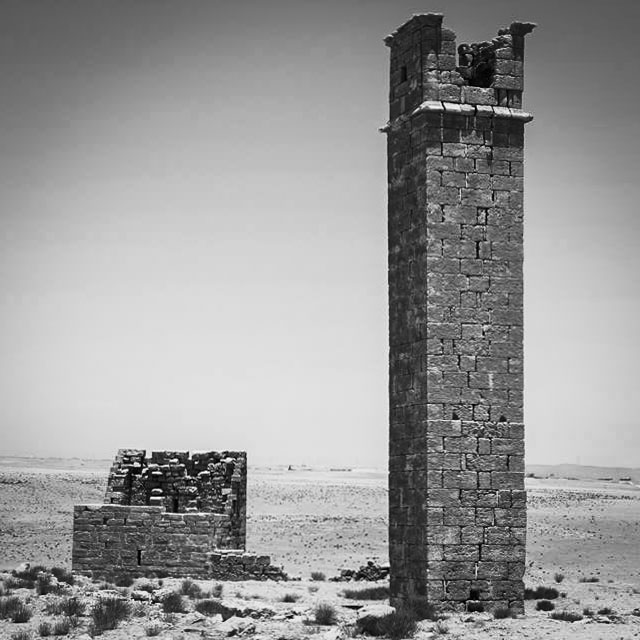
Um er-Rasas, Jordan, by Evan Jewell. The site, formerly known as Kastrom Mefa’a, was originally a Roman military camp (hence, “Kastrom”). Today the primary ancient remains are sixteen Byzantine churches and a stylite–pictured in the stark desert environment–a column-tower built for an ascetic monk who would live there in isolation from the world in the ascetic habit, after St. Simeon’s (d. 459 CE) example.

Um er-Rasas, Jordan, by Evan Jewell. The mosaic pictured here comes from the church of St. Stephen, dated to 785 CE. In part it depicts the cities of the Nile delta in Egypt–conjuring up a world of water and abundance which was far removed (environmentally and geographically) from the Jordanian desert. The boating scene here has been defaced by iconoclasts, either Byzantine (post Emperor Leo) or Ummayad (post Cailph Yazid II) and yet the face of the boatman was carefully replaced with mixed tesserae. This raises questions about the status of an artwork and its aesthetics, and its subordination to and/or interplay with overriding religious and political ideologies.

The Church of the Holy Sepulchre, Jerusalem, by Evan Jewell. This is one of the few sites which we visited that still retains an important connection to contemporary communities and pilgrims. As the stones polished and inscribed by centuries of pilgrims attest, the church is very much a “touched”, tactile, object of ritual and history itself. It was hard not to experience this place: bodies (tourists, pilgrims, clergy) circulating through a pulsing space, enveloped in the smells, light, darkness, ritualised actions, and the objects of reverence and awe.

Jerash, Jordan, by Evan Jewell. Jerash, Gerasa, Antioch-on-the-Chrysorrhoas–the name of the best preserved ancient urban centre in the Levant today has changed with its long history of political, cultural, and religious change, from Hellenistic to Islamic times. So too did its architecture. Scholars believe that the elliptical, colonnaded spaces of the “Oval Plaza” seen here served to visually link the new axis of the Roman city (the “cardo”) to the older, pre-existing axis of the city’s Temple of Zeus, which was monumentalised in the 1st century CE. However, it may have also offered a suitable place for religious festivals, processions, or even market days which may have drawn traders and members of neighbouring communities, together with the spectacles of the Hippodrome and nearby South Theatre.
This week’s winner is Maria Dimitripoulos. Maria participates in a new excavation project at the sanctuary of Poseidon at Onchestos, organized by Professor Ioannis Mylonopoulos. She is traveling in Greece, together with a group of students who will be working with Professor Mylonopoulos, and sent us images from Delphi. Photos and descriptions by Maria Dimitropoulos.
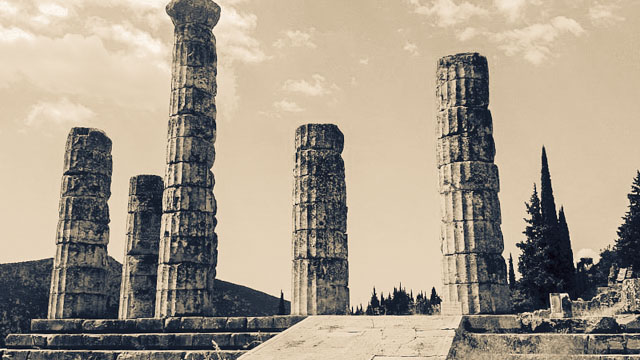
The Temple of Apollo at Delphi, by Maria Dimitropoulos. The ruins of the Temple of Apollo are from the 4th century BCE. According to Pausanias, this structure was built on two earlier temples to Apollo that had been destroyed. The peripteral Doric building was the seat of the Pythia and the Delphic oracle whose influence extended all over the Greek world and beyond.
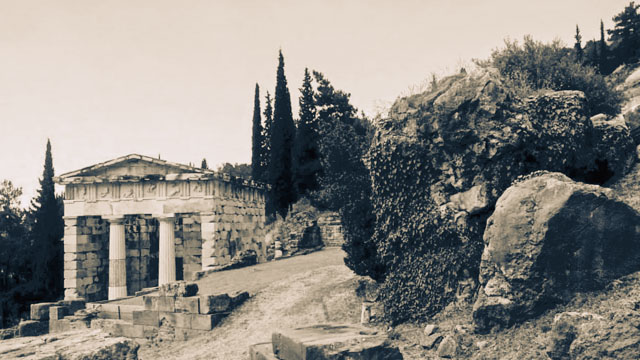
The Treasury of the Athenians and the Rock of the Sybil at the Sanctuary of Apollo at Delphi, by Maria Dimitropoulos. The Treasury of the Athenians, erected perhaps because of their victory at Marathon, is the best preserved structure in Delphi, a sanctuary dedicated to Apollo. The small doric building made of Parian marble resembles a temple.The relief metopes of its frieze show the exploits of Herakles and Theseus. Beside it is the rock on which the sybil sat on when giving the oracles, according to Pausanias.
This week’s winner is Giulia Bonasio, who participates in a conference on Agency and Values, sponsored by the Alliance Program and co-organized by Akeel Bilgrami and Laurent Jaffro. The conference brings together faculty and Ph.D. students from Columbia University and several universities in Paris. Speakers address questions of value and motivation/agency as they are discussed in contemporary and ancient philosophy. Giulia, who will present a paper on Plato’s Symposium, sent us photos from some of her favorite places around the Universities in Paris. Photos and descriptions by Giulia Bonasio.

Sorbonne, Paris, by Giulia Bonasio. The photo shows a famous early 20th century building of the Sorbonne, located in Rue d’Ulm. The facade still reflects the charm of that period in Paris. The building is dedicated to Marie Curie for her outstanding work in chemistry, and has come to be associated with the role of women in research. Today the building belongs to larger structure that gathers the main graduate centers of the Sorbonne in Paris. It is part of the academic life of every PhD student, both in the humanities and the sciences.
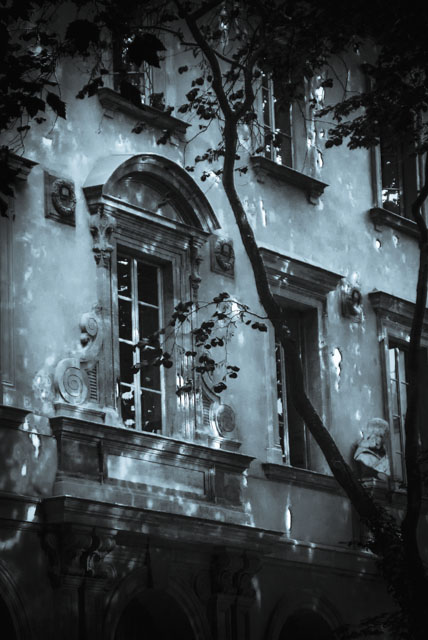
Ecole Normale Superieure, Paris, by Giulia Bonasio. Window from the internal court of the Ecole Normale Superieure (ENS), right outside of the research library of the ENS. A real “space for the mind” due to its tranquility, an ideal place to study in the summer days in Paris.
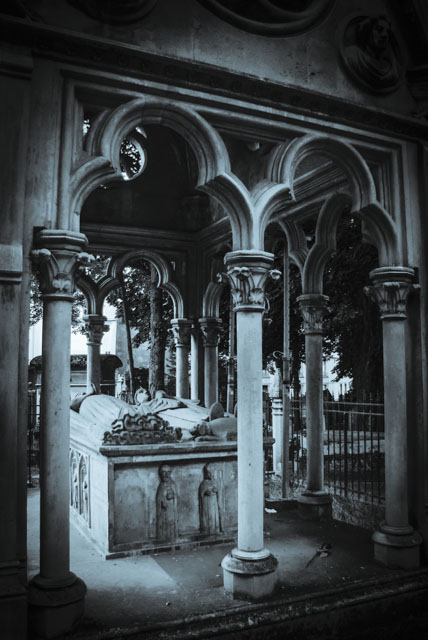
Abelard and Eloise’s grave at the cemetery of Père Lachaise, Paris, by Giulia Bonasio. Many philosophers, poets, musicians, and scientists are buried in this famous cemetery. The grave of Abelard and Eloise is one of the oldest. It is a symbol of a tragic and passionate encounter, documented through letters between Abelard and Eloise. In these letters, philosophy, emotions and religion are the real protagonists.
This week’s winner of the CLST Photo Award is Jeremy Simmons, who visited Rome right after participating in the CAM trip to Israel and Jordan. He sent us a photo of a relief called “Triumph over Judea” from the Arch of Titus in Rome. He says that having just visited Jerusalem and seeing the remains of the Temple Mount, this image resonates all the stronger–it is the final twist of the knife, the ultimate projection of Roman dominance. Photo and description by Jeremy Simmons.
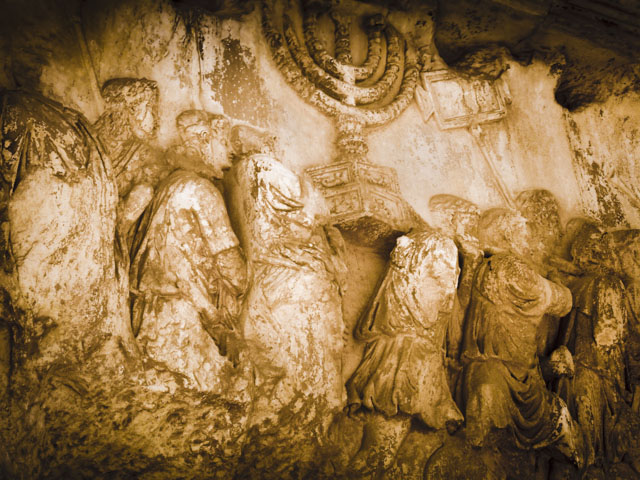
“Triumph over Judea,” Forum Romanum, Italy, by Jeremy Simmons. This relief is found on the triumphal arch of the Emperor Titus, erected to commemorate the Roman subjugation of the First Jewish Revolt and the Sack of Jerusalem. Among the spoils carried is the menorah, a sacred object from the Second Temple and one of the many symbols of the Jewish revolutionaries. This display of power is magnified by concurrent Flavian building projects, as the viewer would have approached from the colossal Flavian amphitheater only to find the monumental Temple of Peace and imperial spice warehouses on the other side. Directionality is key, as an individual leaving the Forum Romanum through this single archway would feel as if trampled by the jubilant mob.
The next winner of the CLST Photo Award is Kathryn Minogue-Nachison. Kathryn participates in a travel seminar entitled “Sacred Image Sacred Space: From Ancient Greece to Byzantium,” co-taught by Professor Holger Klein and Professor Ioannis Mylonopoulos. Kathryn sent us several images, one from Meteora in Thessaly:
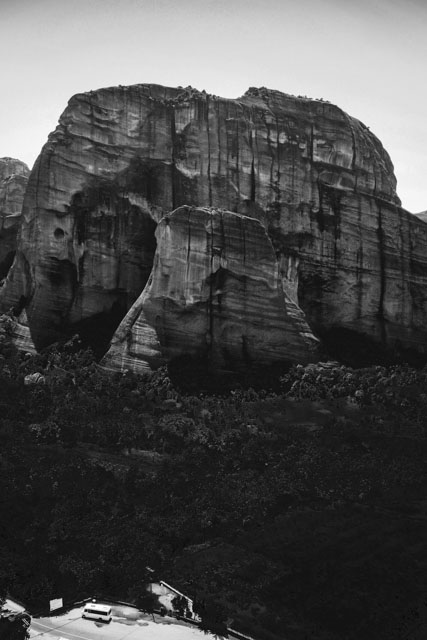
Meteora “suspended in air”, Greece, by Kathryn Minogue-Nachison. During the 11th to 20th centuries, monks inhabited these sandstone cliffs of Thessaly. Though accessible only by rope ladders and pulley nets, they carved out niches in the faces of the mountains and built over 20 monasteries at the peaks. From the St. Nikolaus Monastery, one of the cavernous dwellings can still be seen (on the left). Meteora is one of the most visually stunning sacred spaces of the Greek world.
And another from the Parthenon in Athens:
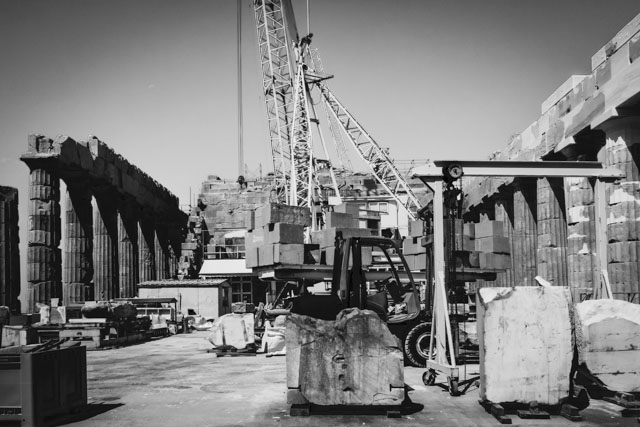
Parthenon, Athenian Acropolis, Greece, by Kathryn Minogue-Nachison. The temple was erected in the 5th century BCE to the patron deity of the city, Athena. From inside the temple, access to which is extremely limited, we can see the far end of the cella where the magnificent 40-foot tall ivory and gold statue of the goddess stood. Nothing of this statue remains. Currently the temple is being carefully restored, which is the reason for the modern equipment inside the temple.
The first winner of the CLST Summer Photo Award is Evan Jewell, who participates in this year’s CAM trip to Israel and Jordan. The photo shows an ancient water channel. As Evan tells us, after purchasing one bottle of water after another, and traveling through the length of the Siq all the way up to one of the highest tombs, the “Monastery”, the importance of water in this ancient, arid world still resonates today. Photo and description by Evan Jewell.
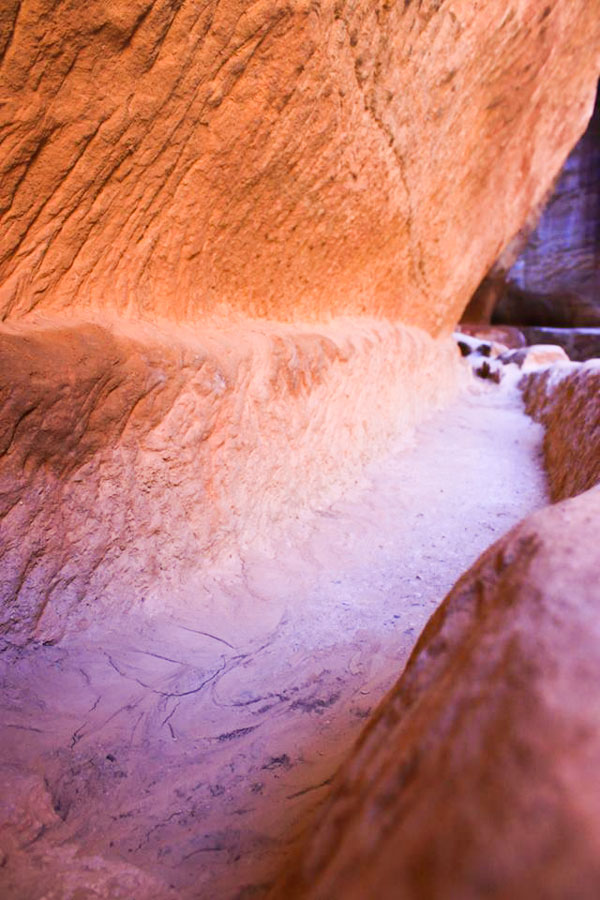
Siq of Petra, Jordan, by Evan Jewell: This photo comes from Petra, the Nabatean capital. It shows a water channel that was carved into the red sandstone of the Siq of Petra. The Siq, a narrow gorge, runs through the mountain. It leads to the Al Khazneh (so-called “treasury”, but probably a tomb) and then to the temples and civic buildings of Petra proper. Water management was central to the continued existence of the cities of Israel and Arabia, just as it is today. The Nabateans were masters of stone carving. This is demonstrated no less so in their ability to manipulate the landscape around them to serve their basic needs.
More soon!






















